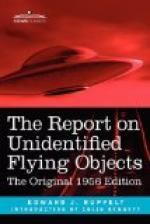If I recall correctly, this pilot was flying for TWA. One day in March 1952 he, his copilot, and a third person who was either a pilot deadheading home or another crew member, I don’t recall which, were flying a C-54 cargo airplane from Chicago to Kansas City. At about 2:30P.M. the pilot was checking in with the CAA radio at Kirksville, Missouri, flying 500 feet on top of a solid overcast. While he was talking he glanced out at his No. 2 engine, which had been losing oil. Directly in line with it, and a few degrees above, he saw a silvery, disk-shaped object. It was too far out to get a really good look at it, yet it was close enough to be able definitely to make out the shape.
The UFO held its relative position with the C-54 for five or six minutes; then the pilot decided to do a little on-the-spot investigating himself. He started a gradual turn toward the UFO and for about thirty seconds he was getting closer, but then the UFO began to make a left turn. It had apparently slowed down because they were still closing on it.
About this time the copilot decided that the UFO was a balloon; it just looked as if the UFO was turning. The pilot agreed halfway—and since the company wasn’t paying them to intercept balloons, they got back on their course to Kansas City. They flew on for a few more minutes with “the darn thing” still off to their left. If it was a balloon, they should be leaving it behind, the pilot recalled thinking to himself; if they made a 45-degree right turn, the “balloon” shouldn’t stay off the left wing; it should drop ’way behind. So they made a 45-degree right turn, and although the “balloon” dropped back a little bit, it didn’t drop back far enough to be a balloon. It seemed to put on speed to try to make a turn outside of the C-54’s turn. The pilot continued on around until he’d made a tight 360-degree turn, and the UFO had followed, staying outside. They could not judge its speed, not knowing how far away it was, but to follow even a C-54 around in a 360-degree turn and to stay outside all of the time takes a mighty speedy object.
This shot the balloon theory right in the head. After the 360-degree turn the UFO seemed to be gradually losing altitude because it was getting below the level of the wings. The pilot decided to get a better look. He asked for full power on all four engines, climbed several thousand feet, and again turned into the UFO. He put the C-54 in a long glide, headed directly toward it. As they closed in, the UFO seemed to lose altitude a little faster and “sank” into the top of the overcast. Just as the C-54 flashed across the spot where the UFO had disappeared, the crew saw it rise up out of the overcast off their right wing and begin to climb so fast that in several seconds it was out of sight.
Both the pilot and copilot wanted to stay around and look for it but No. 2 engine had started to act up soon after they had put on full power for the climb, and they decided that they’d better get into Kansas City.




